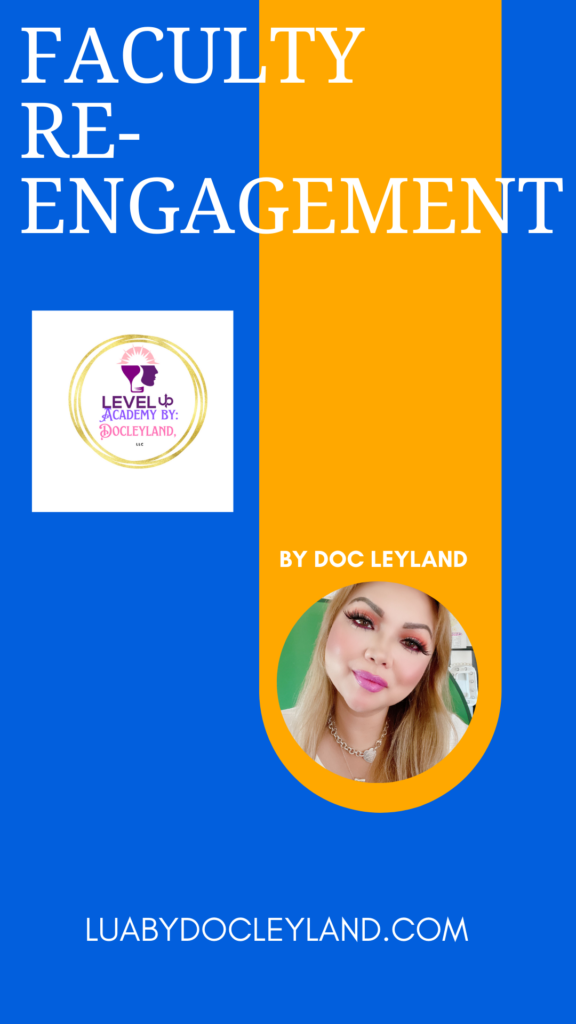
Abstract
In this remote world we live in, we often praise the convenience of taking and teaching classes online but often yearn for camaraderie. COVID-19 forever change the world in every possible way especially in education. Some brick and mortar schools have permanently closed, some schools have closed their buildings but switched to online or hybrid only schools to stay in business. But, fall short on providing tools, support, and ideas for their faculty on how to engage their students. Reengaging faculty’s passion for helping and teaching can be done in multiple ways. This article shows certain ways to re-engage faculty and provide administrators and faculty developers ideas and questions to ask.
Reigniting Our Passion
Once upon a time, teachers and professors had a choice to teach online, on-ground or hybrid. Then came the pandemic. Everyone was forced to go online to teach and learn. For some, it was nothing new, and for others it shows the lack of professional development that institutions should provide for their teachers/ professors. It was new to be going to class via remote for some students and again for other’s there was no transition. But have you ever wondered how some classes have higher ratings in student satisfaction than others? In this exploratory short article, we will explore how I re-engage my faculty during COVID through reigniting their passion for learning and teaching.
Jennifer Bentz, a Senior VP of Insights and Innovation at Tyson Foods supports the idea that public praise can build community in the workplace. She says, “as a cultural tenant in the organization, praise motivates the group to get rid of negativity- it opens up the road to positive interaction and discovery. When optimistic energy is present, the team gets going” (Kuczmarksi.com, n.d., para# 3).
Teaching is a passion of mine and providing a platform for my faculty to grow professionally is always my goal. During the pandemic, one school I taught required me to teach online live for one hour to engage my students but doesn’t provide any tools of how. I created my own agenda, researched my weekly topics, and provided activities in class that my students can engage and discuss how their experiences have changed for good/bad. We learned together, researched together, and created their academic journey together. I had the opportunity to become a Dean of Business and Accounting and I saw a bigger issue, which is the lack of support, corporate culture, and engagement with faculty.
The university conducted surveys and what is common throughout the result is the lack of professional development and peer interaction. I sat down with my team and asked them what kind of corporate culture they would like to see, what would motivate them, how would they see themselves fit in the organization and what are some of the activities they would be interested in doing to feel connected with one another.
Re-engaged with my faculty was one goal in mind and I provided my team professional development training, created a space where we created a faculty summit so they can engage with their peers, share their own expertise with everyone in the University, and learn from others. My faculty wanted to help their students and retain them but didn’t know how or what they could do. I formed a retention committee and created a research team and an action team. The research team finds ways and reads up on other universities on the ways they retain students. They bring it up to the team on their results and the action team finds ways to engage and retain our students through extra office hours, eliminating late policies, working with students on their projects, and providing more one-on-one. We also provided new students training on APA and the technology we used along with expectations and policies in the classroom.
The faculty development and designs were created through providing a corporate culture of open-door policy, transparency, support on both our faculty and students and encouraging my faculty to lead ideas that they would like to participate in. For example, one wanted to celebrate their peers’ work anniversaries and birthdays. Another one wanted to publish a magazine. Another one wanted to publish a book. We all collaborated on ideas that were given by their peers and found a way to make it happen.
If one was to engage faculty developers and pursue to re(engage) faculty, the developers should ask questions to their faculty. Some of the questions should be, what is your purpose? Why do you like to teach? What are some of the activities that you would like to be involved in? What types of committees or ideas would you like to create or lead? What type of professional development courses would you be interested in attending and why?

I also have been team leading at another University where professors are used to asynchronous classrooms. Engaging them was much more difficult as the call to action was based solely on their online presence and live zooms was not a requirement but expected to have a high passing rate in class. Higher education institutions should engage faculty in gamifying their weekly tasks. I have used gamification within my team of faculty for about two years and have seen an increase in participation at more than 70% of their discussion boards within our team. I also see great responses from students who have professors who are active.
So, to conclude, re(engagement) of faculty is not just one thing or one idea, it is a combination of asking the faculty what they would like to do, how would they see themselves serving within the institution, and follow-up by the higher ups on the people who are innovating to praise them and give them credit for their ideas. A simple email to everyone, a simple thank you note, and providing them support on whatever innovative ideas they must benefit both the faculty and the students. If your faculty is happy, your students will also be happy because they feel heard and appreciated.
Reference
Kuczmarksi, S. (n.d.). The Power of Public Praise. https://www.kuczmarski.com/the-power-of-public-praise/#:~:text=Public%20praise%20creates%20positive%20and,culture%20of%20collaboration%20and%20partnership.